If you ever travel to Bali , you should definitely take a few days to discover the highlights in Ubud . Here you’ll experience a beautiful mix of tradition, spirit, and nature. This small town northeast of Denpasar has around 30,000 inhabitants and is considered the cultural center of Bali. We’ve already been there twice and explored the area. You’ll find magnificent temples everywhere, you can witness traditional ceremonies right on the street, and you can enjoy incredibly good food here.
Ubud is somehow magical, even though it’s fairly well developed for tourism. A visit is still worthwhile, whether for 2 days, 3, or even 7. Find out what there is to experience here and what you should try out for yourself in our article about the many highlights in Ubud.
- Rent a scooter in Ubud
- The Monkey Forest
- Green rice terraces and fields
- Temple complexes around Ubud
- Climb Mount Batur volcano
- Street food in Ubud
- Art, street art, and shopping in Ubud
- Kecak Dance – traditional dance performances
- Experience a Balinese ceremony
- Book a hotel in the rice fields
- General information
Rent a scooter in Ubud
Before you do anything, get a scooter first. You’ll be flexible and can even travel to more remote places. Depending on where your accommodation is located, it can be quite a hike to the town center. It’s precisely the surrounding area that makes Ubud so charming – rice fields, volcanoes, temples, and much more. It’s best to ask at your accommodation; you can usually get a scooter organized quickly. You can find out more about this topic here: Renting a scooter in Bali.
Note: You can of course also travel to Ubud by taxi and have a driver take you to the various highlights in Ubud and the surrounding area. Riding a scooter in Bali is generally quite challenging, so be aware of that!

The Monkey Forest
According to the internet and TripAdvisor, the Monkey Forest is one of Ubud’s top attractions. Naturally, we didn’t want to miss it. Located right in the center of town (next to HUBUD), this small temple jungle with around 600 monkeys is the entry fee. The entrance fee is 44,000 IDR (€2.73) per person. Here you can stroll through the enchanted jungle and take a photo or two of these little rascals.
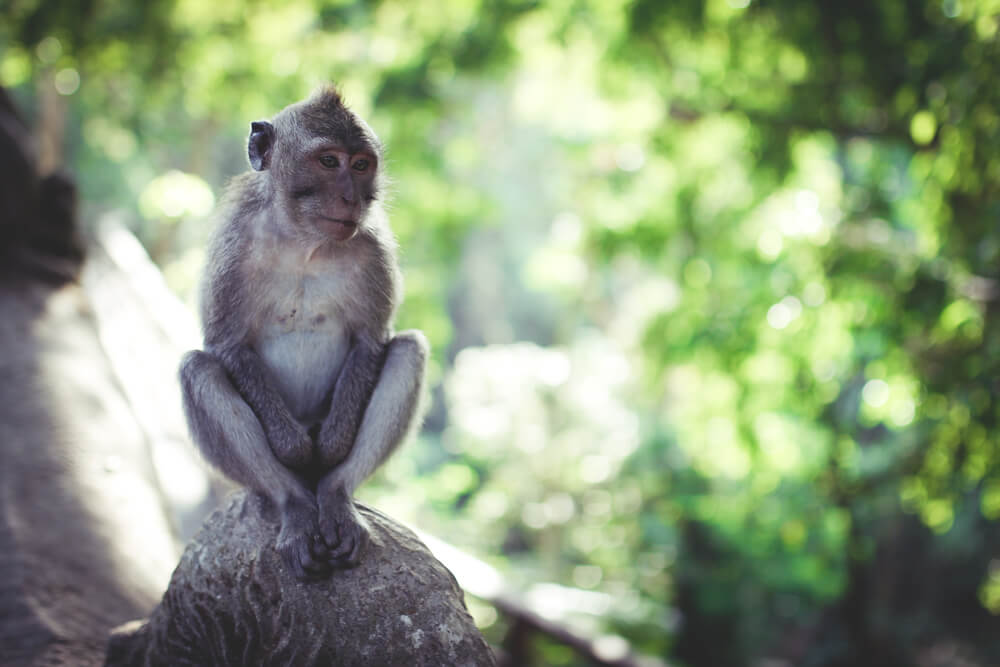
The Monkey Forest is always busy, and you’ll often see people behaving a bit inappropriately to take a photo with a monkey. Watch the animals from a distance and don’t necessarily chase them. They are still wild animals, even if they have become very accustomed to humans.

But be careful! The monkeys can sometimes be very cheeky and like to look in your purse or backpack. So leave your sunglasses, hat, etc. in your bag or at home. Monkeys can also bite, and there are still reported cases of rabies. Therefore, vaccination is essential before traveling (there are stray dogs roaming around everywhere). Health insurance companies usually cover rabies vaccinations—so it’s better to be a little more proactive than too little.
Green Rice Terraces and Fields
No other island is as characterized by rice fields as Bali. They are architectural masterpieces and characterize the landscape of Bali. The area around Ubud is arguably one of the most beautiful. Grab your scooter and just drive – you’ll quickly pass many fields. About half an hour north of Ubud are the famous Tegalalang Rice Terraces.

Even from a distance, you can see the rice terraces laid out on the mountain. Here, you can climb the mountain along the rice terraces in a serpentine fashion. If you’re there at the right time and in good weather, everything shines in lush green. You’ll often see locals cultivating, tending, and harvesting these fields/terraces. The Balinese also call the many rice terraces “the stairways of the gods.”

Located just under 40 kilometers northwest of Ubud, you’ll find the Jatiluwih Rice Terraces. Not far from there is the Gunung Batukau volcano, which rises to over 2,270 meters. If you want to travel from Ubud to Amed, then check out the rice terraces around Tirtagangga and Karangasem on the way.

Temple Complexes around Ubud
Bali is not only known for its beautiful rice fields, but also for its many magnificent temple complexes. You can discover and enjoy these buildings all over the island. One of the most beautiful is probably the Pura Ulun Danu Beratan. Inside the water temple (it protrudes from the water) there are even several Buddha statues. This temple is located northwest of Ubud. A trip to the Tanah Lot Sea Temple is also recommended. The temple is located directly on the coast and is particularly impressive due to its scenic backdrop.
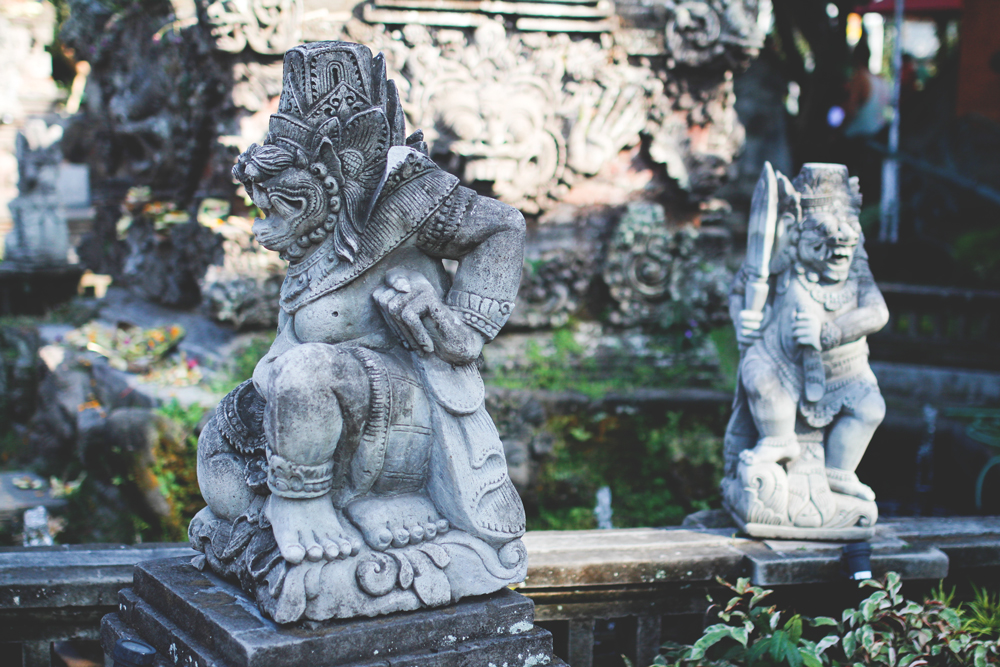
Just about 30 minutes north of Ubud is the Pura Gunung Kawi. You reach the temple complex via a stone staircase carved into the rock. It was built in the 11th century and is one of the oldest and largest monuments in Bali. At the foot of the rice fields are nine tombs carved into the stone. Four of these are known as the “Tombs of the Queens.” Somehow, this place is mystical, but at the same time, it is also an incredibly beautiful natural idyll.

Other temples in Bali: Pura Gunung Kawi Sebatu, Pura Tirta Empul, Mother Temple Pura Besakih with the Elephant Cave Goa Gajah, Saraswati Temple Ubud, Pura Dalem Agung Padangtegal, Pura Puseh Ubud, Ubud Water Palace, Kecak Dance Pura Dalem Taman Kaja, and many more.
Insider tip: Half an hour from Ubud is the beautiful Tegenungan Waterfall. And if you still haven’t had enough, head to the Tirta Empul water temple. Balinese believers purify themselves here with holy water to free themselves from worries and illnesses.

Climbing Mount Batur Volcano
How about a quick trip to one of the many volcanoes? There are many active volcanoes throughout the island, which continually provide fertile soil for the cultivation of rice, spices, and fruit. Many of the volcanoes house sacred temple complexes or are even sacred themselves. From Ubud, drive north and arrive at Mount Batur after about 1.5 hours. This massif consists of several volcanic cones and has a height of around 1717 meters. It’s not exactly the highest volcano, but it is the most active.
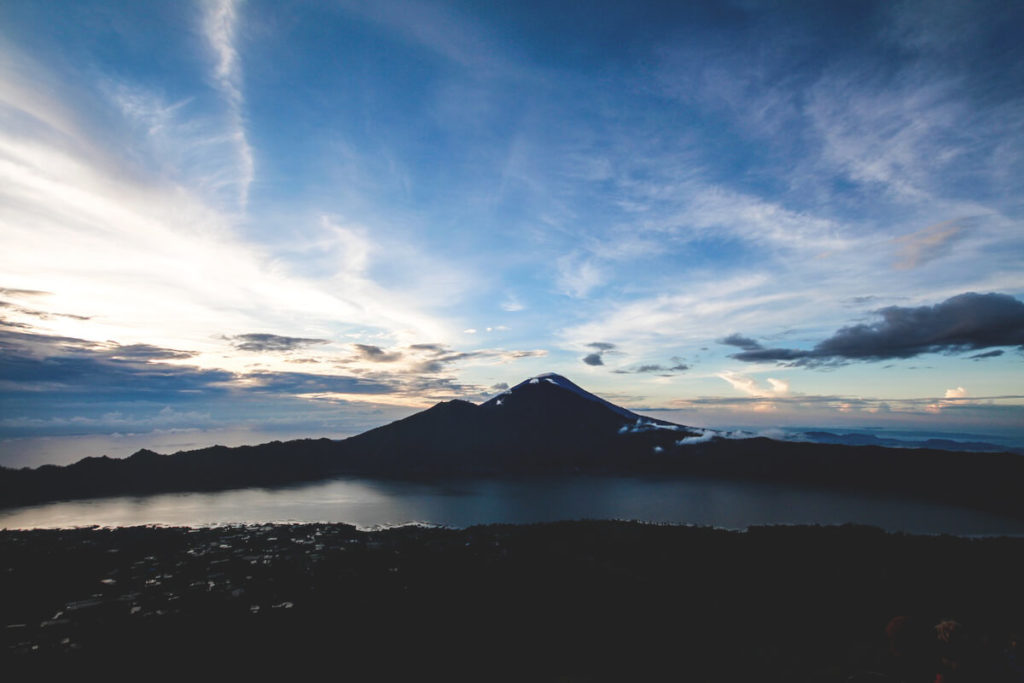
We took a beautiful and unique sunrise tour of Mount Batur. Our driver picked us up in the middle of the night around 2 a.m. Then we went to the base of the volcano, where our guide was already waiting for us. Armed with flashlights and many other adventurers, we headed high up.
We were at the top just in time for sunrise – simply magical and magnificent. We highly recommend this tour; it’s hard to put into words. We booked the tour directly in Ubud. a tourist counter for around €20 to €25.
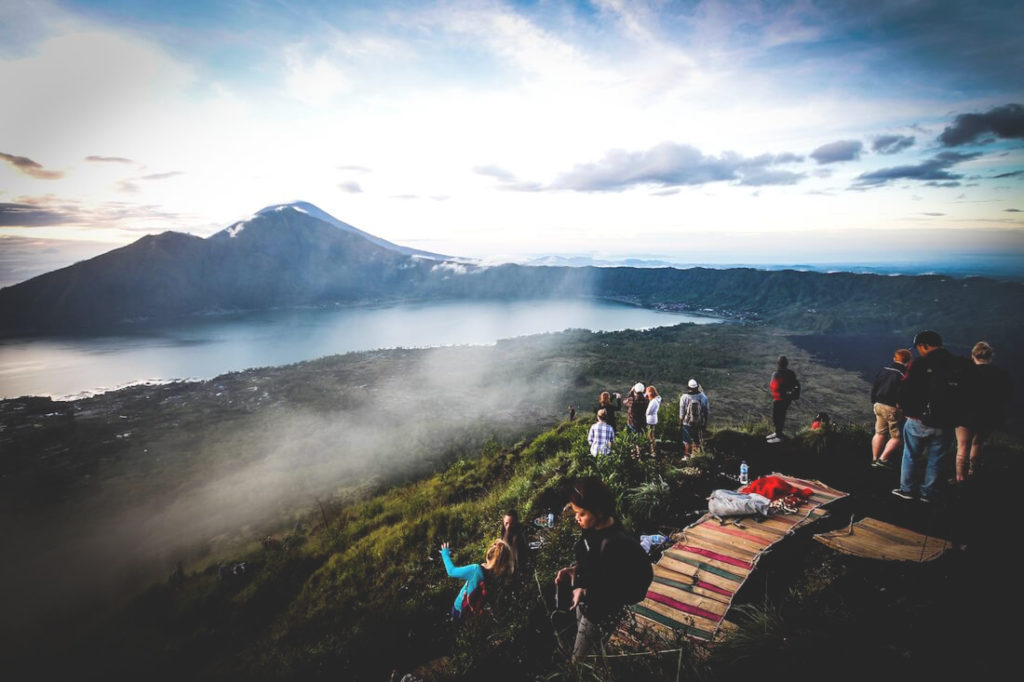
East of Batur is the highest mountain on the island – Gunung Agung (Great Mountain). The Balinese consider it the seat of the gods. It last erupted in 1963, killing almost 2,000 people.
Street food in Ubud
You can get delicious and inexpensive food all over the island. Just find the nearest warung and be surprised. In these small At street stalls/food carts, you can get delicious soups and rice dishes for as little as €1. They often serve these dishes quite spicy! If you don’t like spicy food, you should let them know beforehand.
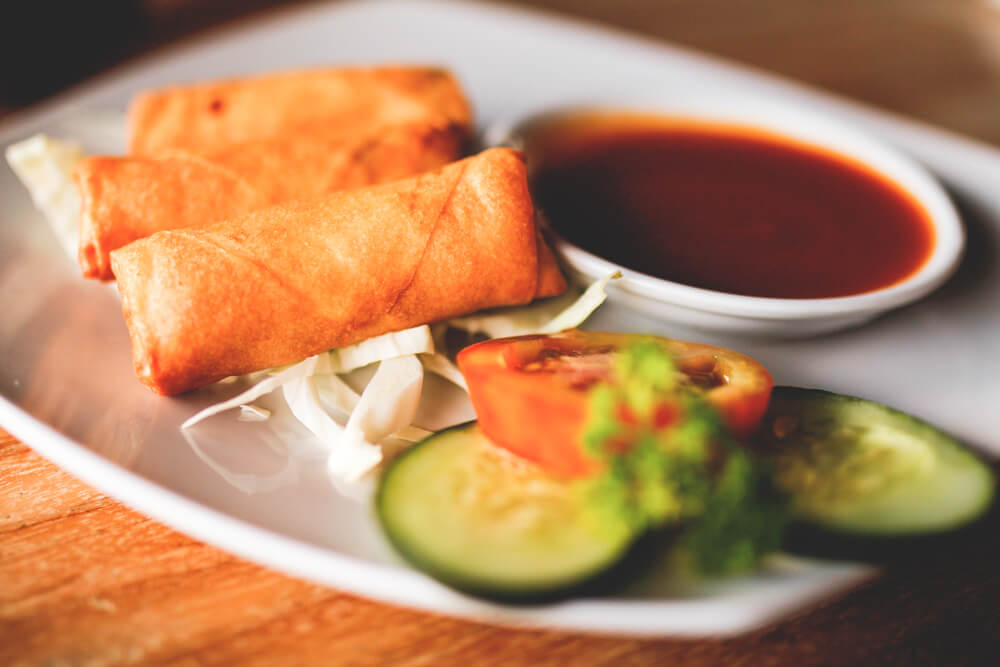
Nasi Goreng is a common rice dish in Indonesia, served in the form of fried rice with other ingredients such as vegetables, chicken, shrimp (veggie-friendly), etc. If you prefer noodles, you should order Bami Goreng. Not only delicious but also inexpensive – just €2 to €3.
Don’t feel like eating rice every day? In Ubud, you’ll find numerous Western restaurants to suit almost every taste. I love pasta and pizza, and I’ve found a favorite at Black Beach. For just €3 to €4, you can get delicious pasta, gnocchi, or pizza with a drink. Delicious coffee is available at Seniman Coffee and Juice la Cafe. You can also get café latte and the like at HUBUD.
Art, Street Art, and Shopping in Ubud
There are a lot of really cool shops in Ubud. Some of them are familiar from Germany or other countries: Billabong, O’Neill, Roxy, and all the other cool surf shops. On every corner, you’ll find scarves (sarongs), dresses, shirts, and the like, as well as beautiful wooden figures, cool decorative items, and super stylish canvas prints. If you’re just visiting the island and then flying back to Germany, you should get an extra suitcase and shop to your heart’s content.
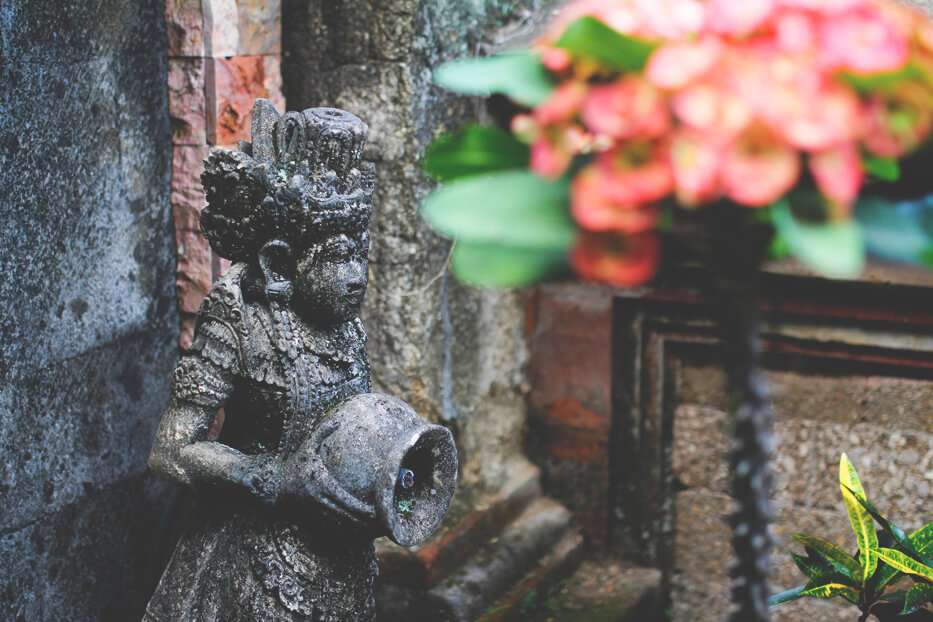
I could buy sooooo much there, you wouldn’t believe it. But on a trip around the world, that would be pretty impractical. Oh yeah, if you need a pair of casual, cool shoes, you should go to Wakai. Otherwise, there are simply too many opportunities to spend money in Ubud – just see for yourself.
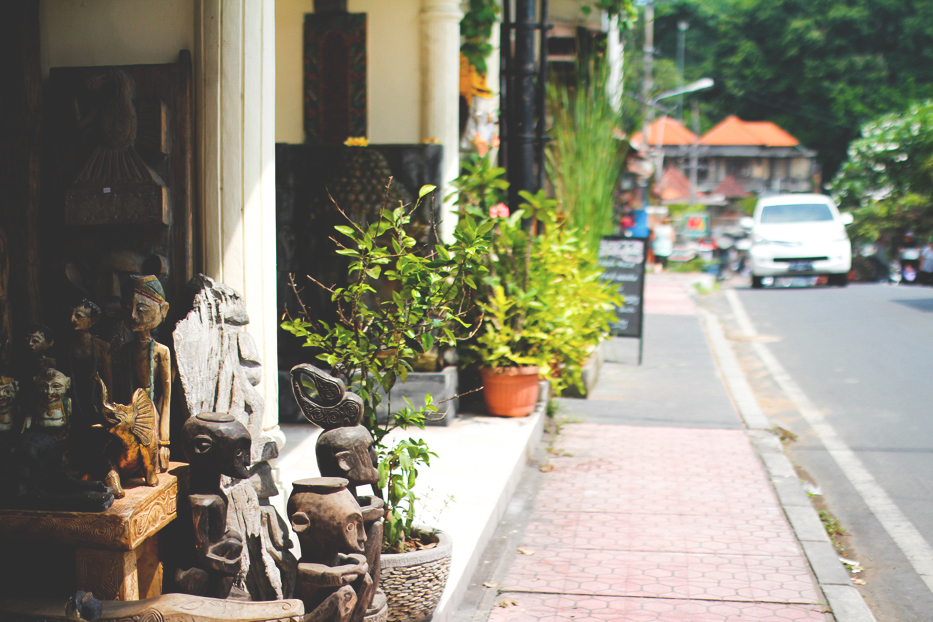
There’s also a lot of kitsch here. If you like crowds, then close your eyes and get through it. Otherwise, you’ll get exactly the same thing in the streets of Ubud as you would at markets like these. Instead, stroll through the beautiful streets of Ubud and let yourself go. The art scene in Ubud is particularly distinctive and popular. Musicians, photographers, designers, and artisans congregate here in the cultural center, and you’ll also find several museums and many galleries in Ubud (e.g., the Agung Rai Museum of Art).

Kecak Dance – Traditional Dance Performances
When you’re in Ubud, you should also take time to see the traditional Kecak Dance. This ancient Balinese dance drama is accompanied by a choir of up to 100 singers. The men sit in a circle, while the actual action takes place in the center.
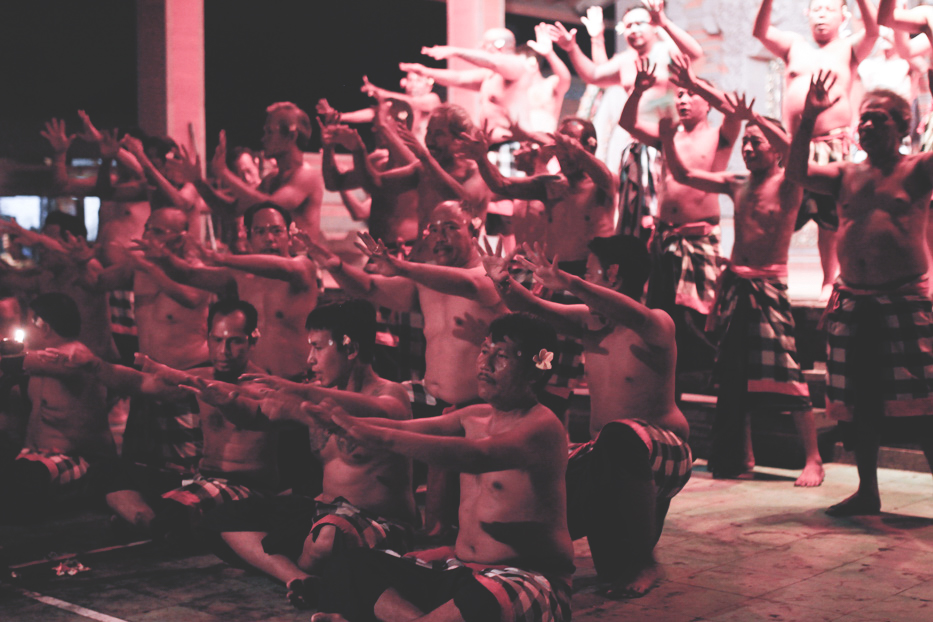
Dancers tell the story of Princess Sita, the monkey general Hanuman, and the demon Ravana. Although we didn’t always fully understand what it was about, the performance was still a truly beautiful highlight for us in Ubud. In the center of Ubud, we found a ticket office where we could buy tickets for a performance (around €8 to €10 per person).
Experience a Balinese ceremony
Almost 95% of the population on Bali are Hindu, even though the rest of Indonesia is predominantly Muslim. Crazy, right? Ceremonies often take place right in the middle of Bali’s streets. The various phases of the moon, which are of great significance in Bali, are celebrated accordingly. These days are calculated from various calendars, but ceremonies take place almost daily.

Many ceremonies take place privately, for example, when a family member is born or dies. Large groups of Balinese people wearing white headscarves walk through the streets and head to one of the many temples. These celebrations are usually public, but you should still check and inquire beforehand.

Book a hotel in the rice fields
We had really nice accommodations both times we were in Ubud. We particularly liked “The Sowan Ubud,” located in the middle of Ubud’s rice fields. This guesthouse leaves nothing to be desired and is still not too expensive. Just 10 minutes from the Monkey Forest, cozy rooms with views of the rice fields and the pool await you.
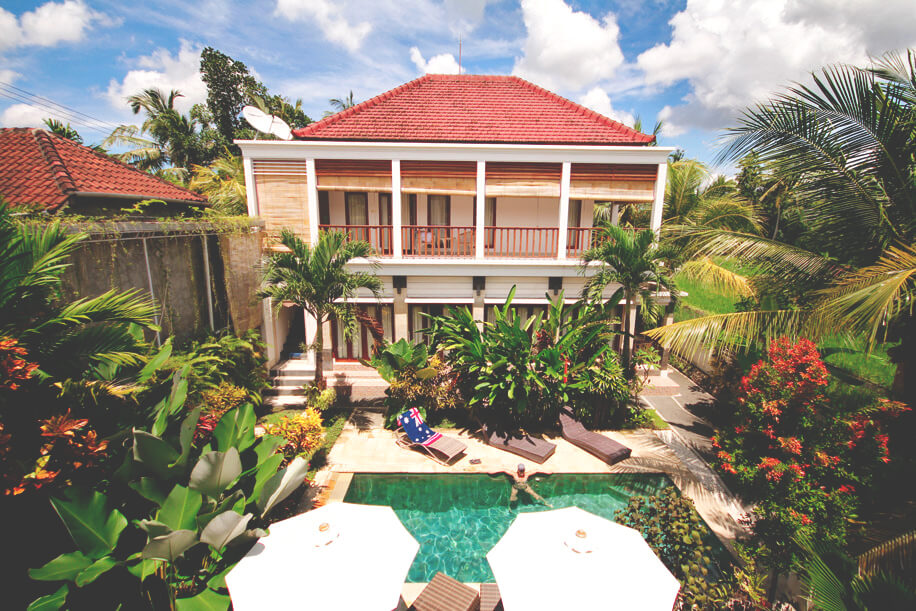
The rooms are truly spacious, air-conditioned, and beautifully furnished. The two upstairs rooms also have a small terrace with chairs and a table. There’s a different breakfast to choose from every day—sometimes American, sometimes Indonesian, and so on. We truly enjoyed our time there and highly recommend this accommodation. In general, you can find many great accommodations in Ubud and, in fact, throughout the entire island. It’s best to check out The Sowan Ubud or Airbnb.

General Information
Getting to Ubud
From Kuta/Denpasar, it’s about 1.5 to 2 hours to Ubud. We took a taxi (Blue Bird Taxi) from Kuta to Ubud for just under €16 (250,000 IDR), but there are also minibuses that run for around €4 (60,000 IDR). However, taking a taxi was easier and more convenient. Otherwise, the “Kura Kura” buses also travel between the larger cities (all information here). You can also simply drive a scooter yourself (Rent a scooter in Bali) if you feel like it. In the end, it’s usually a matter of negotiation.
Don’t always take the first offer you see. Ask around and get a feel for the price. In Ubud itself, there are many small offices where you can sign up for the shuttle buses. Simply pay directly, provide your pickup address and date, and wait for the minibus the next day. We rode back to Kuta Beach with about 10 other people for just under €4.
Withdrawing money & exchange offices
In Bali, you pay with the Indonesian rupiah. The exchange rate fluctuates; currently, you get around 15,900 IDR for one euro. You should definitely have a Visa card with you to withdraw cash. It’s even better if you have a second card with you (preferably from a different bank). We’ve often encountered situations where our DKB Visa card didn’t work at some ATMs. However, the problem was probably with Visa itself. With the DKB card, at least you don’t pay fees abroad (if you’re an active customer).
And if fees do occur, simply email DKB and you’ll get the money refunded immediately. A plan B is always good, though – ours is Number26. It’s a reloadable MasterCard and has worked perfectly so far. You can find exchange offices on every corner, but always check the current exchange rate. Rates often vary by a few hundred rupees from place to place.
Internet in Ubud
Ah…the good internet in Bali. If you want to check Facebook every now and then or just send the occasional WhatsApp message, you’ll be fine. Free Wi-Fi is available in most cafes, accommodations, stores, and restaurants. But if you often work on your laptop, want to upload videos, send photos, or download anything, you’ll have a real problem here. The internet has been extremely slow almost everywhere. The only option for truly stable and good internet is in HUBUD.
Unfortunately, you’ll have to dig deep into your pockets for this. You pay €14 for a day pass (fiber optic connection, great Wi-Fi). You also get “normal access” for two hours free with a drink in the cafe. However, this Wi-Fi is just as bad as in the rest of the city. Hubud memberships are expensive, but probably the only way to access fast and secure internet (as of April 2019).
Shopping in Ubud
There are many shops where you can buy food and cooking. It has to be said that shopping is really expensive in Bali, much more so than initially expected. This is probably also because all the “Western products” are expensive, and Balinese people are more into other types of food. It’s only cheap at traditional markets or in small street shops if you want to buy fruit and vegetables.
In Bali, you’ll find a Circle K store on almost every corner. These are small shops with the most important and everyday items, such as drinks, bread, cigarettes, sweets, etc. These shops are somewhat reminiscent of a gas station. Larger supermarket chains include Coco Market, Delte Dewata, Grandlucky, Lotte Mart, Hardys, and Carrefour.